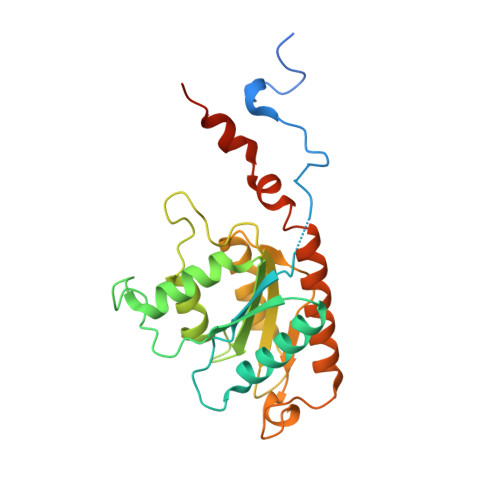The ArsH Protein Product of the Paracoccus denitrificans ars Operon Has an Activity of Organoarsenic Reductase and Is Regulated by a Redox-Responsive Repressor.
Sedlacek, V., Kryl, M., Kucera, I.(2022) Antioxidants (Basel) 11
- PubMed: 35624766
- DOI: https://doi.org/10.3390/antiox11050902
- Primary Citation of Related Structures:
7PLE - PubMed Abstract:
Paracoccus denitrificans ArsH is encoded by two identical genes located in two distinct putative arsenic resistance ( ars ) operons. Escherichia coli -produced recombinant N-His 6 -ArsH was characterized both structurally and kinetically. The X-ray structure of ArsH revealed a flavodoxin-like domain and motifs for the binding of flavin mononucleotide (FMN) and reduced nicotinamide adenine dinucleotide phosphate (NADPH). The protein catalyzed FMN reduction by NADPH via ternary complex mechanism. At a fixed saturating FMN concentration, it acted as an NADPH-dependent organoarsenic reductase displaying ping-pong kinetics. A 1:1 enzymatic reaction of phenylarsonic acid with the reduced form of FMN (FMNH 2 ) and formation of phenylarsonous acid were observed. Growth experiments with P. denitrificans and E. coli revealed increased toxicity of phenylarsonic acid to cells expressing arsH , which may be related to in vivo conversion of pentavalent As to more toxic trivalent form. ArsH expression was upregulated not only by arsenite, but also by redox-active agents paraquat, tert-butyl hydroperoxide and diamide. A crucial role is played by the homodimeric transcriptional repressor ArsR, which was shown in in vitro experiments to monomerize and release from the DNA-target site. Collectively, our results establish ArsH as responsible for enhancement of organo-As(V) toxicity and demonstrate redox control of ars operon.
Organizational Affiliation:
Department of Biochemistry, Faculty of Science, Masaryk University, Kotlářská 2, 611 37 Brno, Czech Republic.














